Engaging Communities in Dengue Prevention: Strategies, Capacity Building, and Models
VerifiedAdded on 2023/06/05
|10
|3030
|127
AI Summary
This report discusses the strategies, capacity building, and models for engaging communities in dengue prevention. It explores the Laverack's ladder of community-based interaction approach and the core domains of capacity building. It also discusses the rationale model, health belief model, and theory of planned behavior for motivating and educating communities about dengue.
Contribute Materials
Your contribution can guide someone’s learning journey. Share your
documents today.
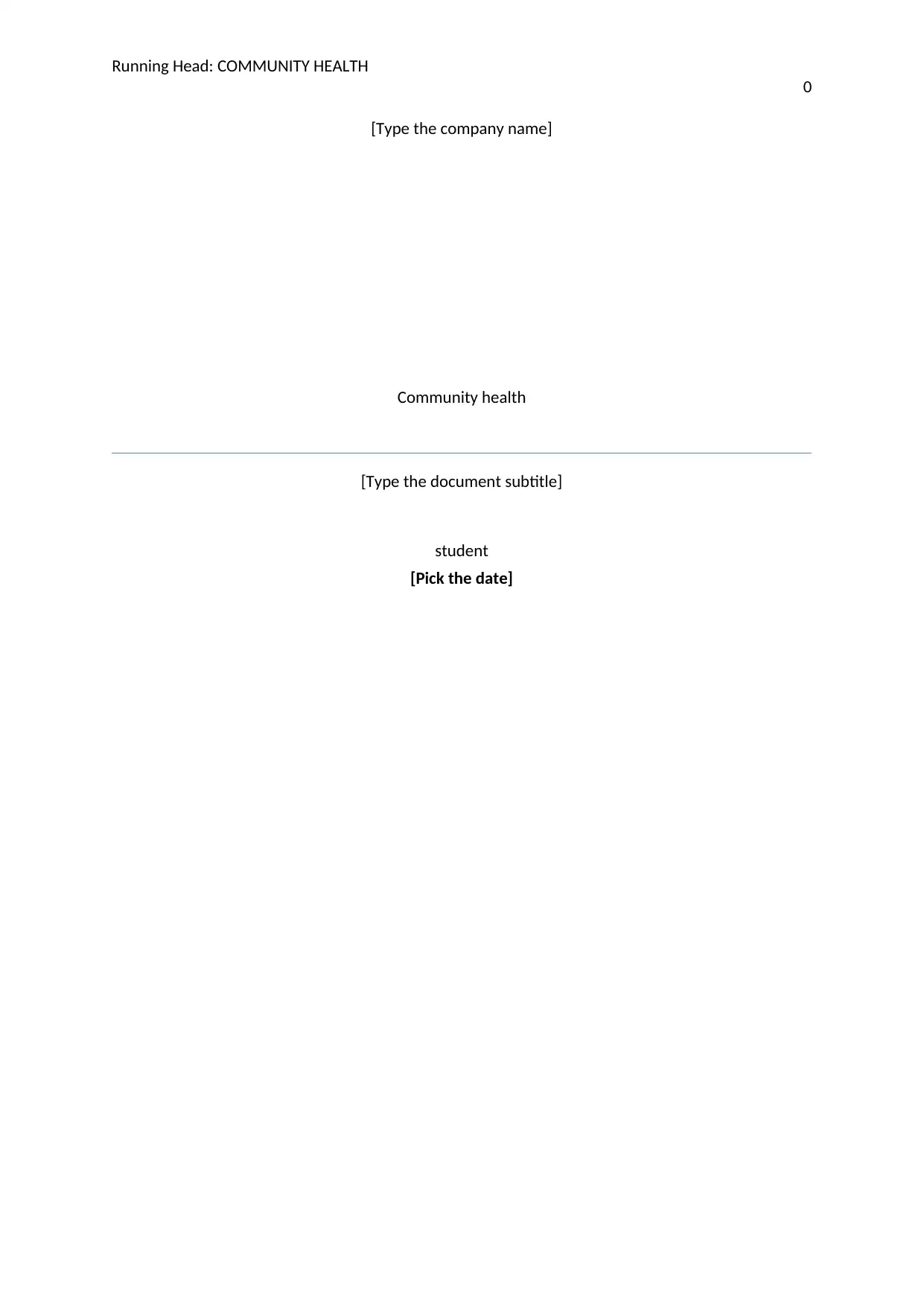
Running Head: COMMUNITY HEALTH
0
[Type the company name]
Community health
[Type the document subtitle]
student
[Pick the date]
0
[Type the company name]
Community health
[Type the document subtitle]
student
[Pick the date]
Secure Best Marks with AI Grader
Need help grading? Try our AI Grader for instant feedback on your assignments.
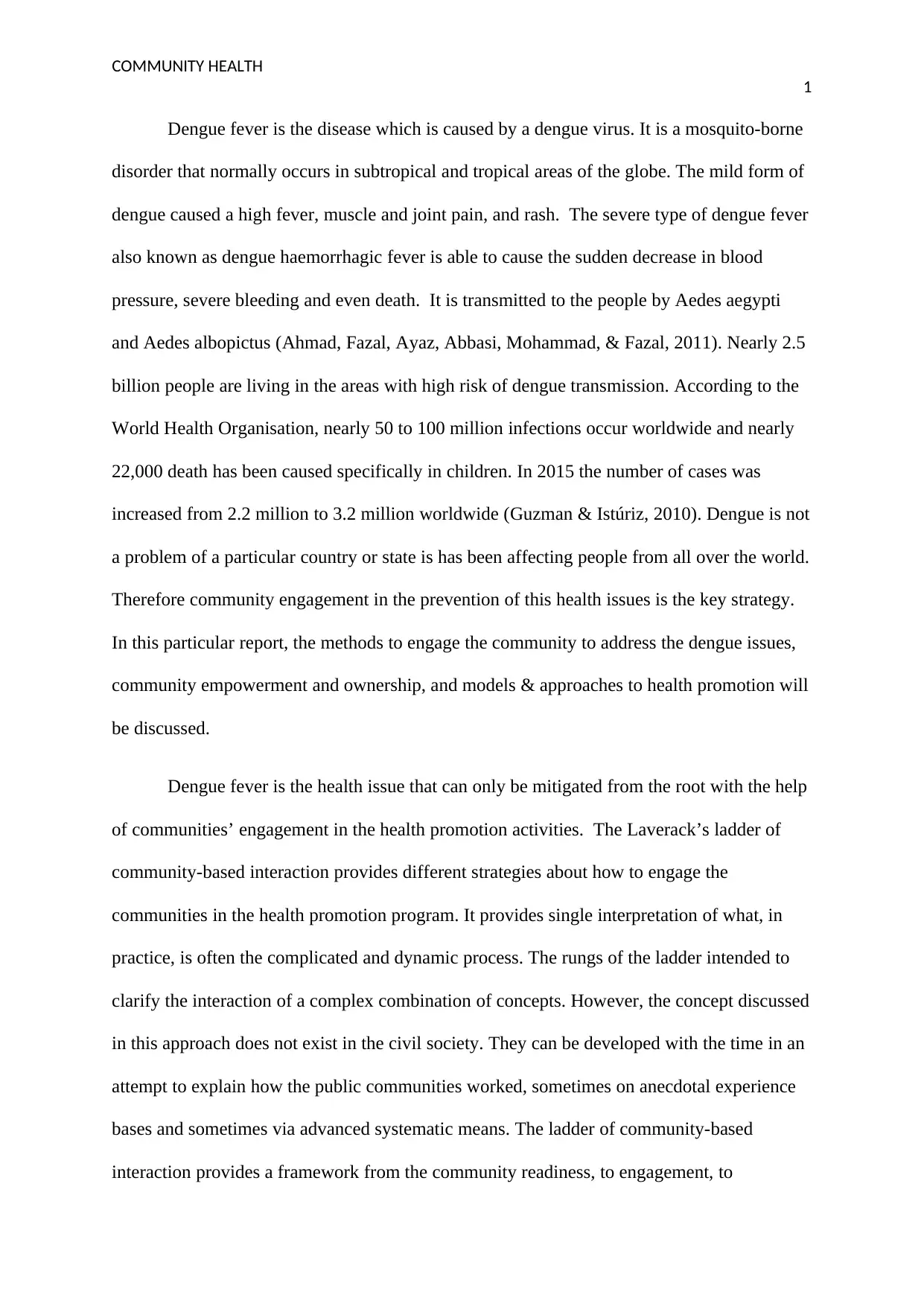
COMMUNITY HEALTH
1
Dengue fever is the disease which is caused by a dengue virus. It is a mosquito-borne
disorder that normally occurs in subtropical and tropical areas of the globe. The mild form of
dengue caused a high fever, muscle and joint pain, and rash. The severe type of dengue fever
also known as dengue haemorrhagic fever is able to cause the sudden decrease in blood
pressure, severe bleeding and even death. It is transmitted to the people by Aedes aegypti
and Aedes albopictus (Ahmad, Fazal, Ayaz, Abbasi, Mohammad, & Fazal, 2011). Nearly 2.5
billion people are living in the areas with high risk of dengue transmission. According to the
World Health Organisation, nearly 50 to 100 million infections occur worldwide and nearly
22,000 death has been caused specifically in children. In 2015 the number of cases was
increased from 2.2 million to 3.2 million worldwide (Guzman & Istúriz, 2010). Dengue is not
a problem of a particular country or state is has been affecting people from all over the world.
Therefore community engagement in the prevention of this health issues is the key strategy.
In this particular report, the methods to engage the community to address the dengue issues,
community empowerment and ownership, and models & approaches to health promotion will
be discussed.
Dengue fever is the health issue that can only be mitigated from the root with the help
of communities’ engagement in the health promotion activities. The Laverack’s ladder of
community-based interaction provides different strategies about how to engage the
communities in the health promotion program. It provides single interpretation of what, in
practice, is often the complicated and dynamic process. The rungs of the ladder intended to
clarify the interaction of a complex combination of concepts. However, the concept discussed
in this approach does not exist in the civil society. They can be developed with the time in an
attempt to explain how the public communities worked, sometimes on anecdotal experience
bases and sometimes via advanced systematic means. The ladder of community-based
interaction provides a framework from the community readiness, to engagement, to
1
Dengue fever is the disease which is caused by a dengue virus. It is a mosquito-borne
disorder that normally occurs in subtropical and tropical areas of the globe. The mild form of
dengue caused a high fever, muscle and joint pain, and rash. The severe type of dengue fever
also known as dengue haemorrhagic fever is able to cause the sudden decrease in blood
pressure, severe bleeding and even death. It is transmitted to the people by Aedes aegypti
and Aedes albopictus (Ahmad, Fazal, Ayaz, Abbasi, Mohammad, & Fazal, 2011). Nearly 2.5
billion people are living in the areas with high risk of dengue transmission. According to the
World Health Organisation, nearly 50 to 100 million infections occur worldwide and nearly
22,000 death has been caused specifically in children. In 2015 the number of cases was
increased from 2.2 million to 3.2 million worldwide (Guzman & Istúriz, 2010). Dengue is not
a problem of a particular country or state is has been affecting people from all over the world.
Therefore community engagement in the prevention of this health issues is the key strategy.
In this particular report, the methods to engage the community to address the dengue issues,
community empowerment and ownership, and models & approaches to health promotion will
be discussed.
Dengue fever is the health issue that can only be mitigated from the root with the help
of communities’ engagement in the health promotion activities. The Laverack’s ladder of
community-based interaction provides different strategies about how to engage the
communities in the health promotion program. It provides single interpretation of what, in
practice, is often the complicated and dynamic process. The rungs of the ladder intended to
clarify the interaction of a complex combination of concepts. However, the concept discussed
in this approach does not exist in the civil society. They can be developed with the time in an
attempt to explain how the public communities worked, sometimes on anecdotal experience
bases and sometimes via advanced systematic means. The ladder of community-based
interaction provides a framework from the community readiness, to engagement, to
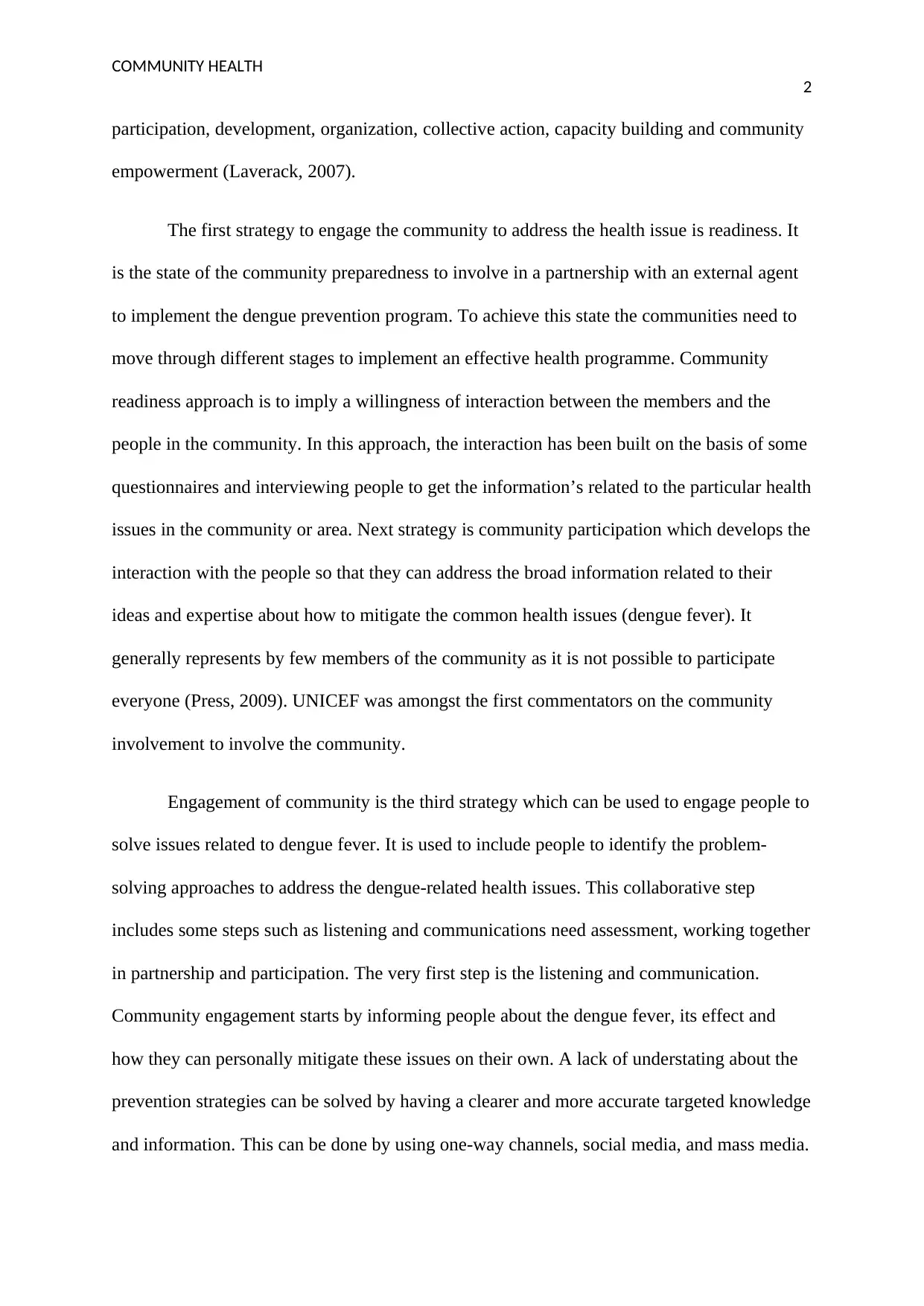
COMMUNITY HEALTH
2
participation, development, organization, collective action, capacity building and community
empowerment (Laverack, 2007).
The first strategy to engage the community to address the health issue is readiness. It
is the state of the community preparedness to involve in a partnership with an external agent
to implement the dengue prevention program. To achieve this state the communities need to
move through different stages to implement an effective health programme. Community
readiness approach is to imply a willingness of interaction between the members and the
people in the community. In this approach, the interaction has been built on the basis of some
questionnaires and interviewing people to get the information’s related to the particular health
issues in the community or area. Next strategy is community participation which develops the
interaction with the people so that they can address the broad information related to their
ideas and expertise about how to mitigate the common health issues (dengue fever). It
generally represents by few members of the community as it is not possible to participate
everyone (Press, 2009). UNICEF was amongst the first commentators on the community
involvement to involve the community.
Engagement of community is the third strategy which can be used to engage people to
solve issues related to dengue fever. It is used to include people to identify the problem-
solving approaches to address the dengue-related health issues. This collaborative step
includes some steps such as listening and communications need assessment, working together
in partnership and participation. The very first step is the listening and communication.
Community engagement starts by informing people about the dengue fever, its effect and
how they can personally mitigate these issues on their own. A lack of understating about the
prevention strategies can be solved by having a clearer and more accurate targeted knowledge
and information. This can be done by using one-way channels, social media, and mass media.
2
participation, development, organization, collective action, capacity building and community
empowerment (Laverack, 2007).
The first strategy to engage the community to address the health issue is readiness. It
is the state of the community preparedness to involve in a partnership with an external agent
to implement the dengue prevention program. To achieve this state the communities need to
move through different stages to implement an effective health programme. Community
readiness approach is to imply a willingness of interaction between the members and the
people in the community. In this approach, the interaction has been built on the basis of some
questionnaires and interviewing people to get the information’s related to the particular health
issues in the community or area. Next strategy is community participation which develops the
interaction with the people so that they can address the broad information related to their
ideas and expertise about how to mitigate the common health issues (dengue fever). It
generally represents by few members of the community as it is not possible to participate
everyone (Press, 2009). UNICEF was amongst the first commentators on the community
involvement to involve the community.
Engagement of community is the third strategy which can be used to engage people to
solve issues related to dengue fever. It is used to include people to identify the problem-
solving approaches to address the dengue-related health issues. This collaborative step
includes some steps such as listening and communications need assessment, working together
in partnership and participation. The very first step is the listening and communication.
Community engagement starts by informing people about the dengue fever, its effect and
how they can personally mitigate these issues on their own. A lack of understating about the
prevention strategies can be solved by having a clearer and more accurate targeted knowledge
and information. This can be done by using one-way channels, social media, and mass media.
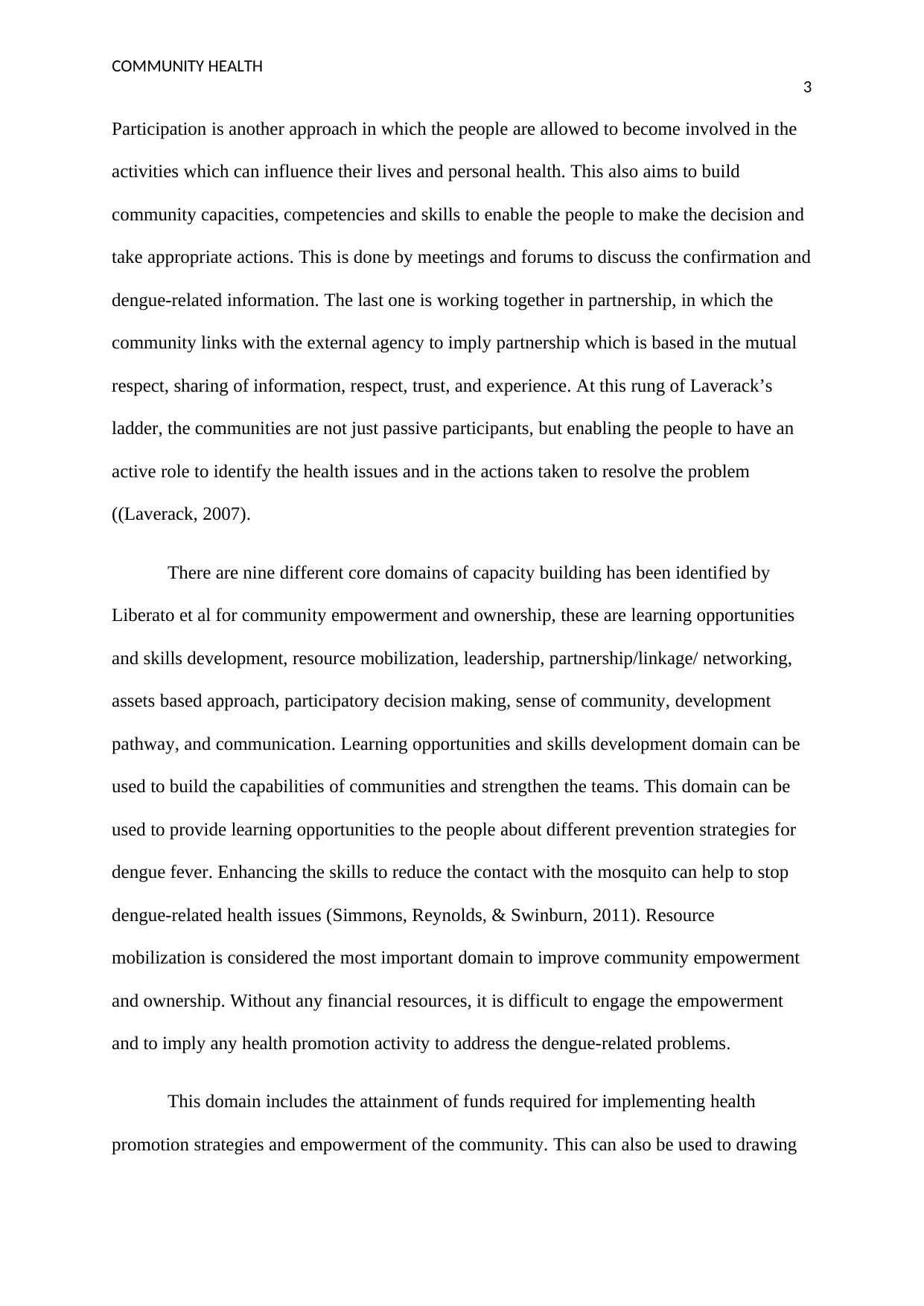
COMMUNITY HEALTH
3
Participation is another approach in which the people are allowed to become involved in the
activities which can influence their lives and personal health. This also aims to build
community capacities, competencies and skills to enable the people to make the decision and
take appropriate actions. This is done by meetings and forums to discuss the confirmation and
dengue-related information. The last one is working together in partnership, in which the
community links with the external agency to imply partnership which is based in the mutual
respect, sharing of information, respect, trust, and experience. At this rung of Laverack’s
ladder, the communities are not just passive participants, but enabling the people to have an
active role to identify the health issues and in the actions taken to resolve the problem
((Laverack, 2007).
There are nine different core domains of capacity building has been identified by
Liberato et al for community empowerment and ownership, these are learning opportunities
and skills development, resource mobilization, leadership, partnership/linkage/ networking,
assets based approach, participatory decision making, sense of community, development
pathway, and communication. Learning opportunities and skills development domain can be
used to build the capabilities of communities and strengthen the teams. This domain can be
used to provide learning opportunities to the people about different prevention strategies for
dengue fever. Enhancing the skills to reduce the contact with the mosquito can help to stop
dengue-related health issues (Simmons, Reynolds, & Swinburn, 2011). Resource
mobilization is considered the most important domain to improve community empowerment
and ownership. Without any financial resources, it is difficult to engage the empowerment
and to imply any health promotion activity to address the dengue-related problems.
This domain includes the attainment of funds required for implementing health
promotion strategies and empowerment of the community. This can also be used to drawing
3
Participation is another approach in which the people are allowed to become involved in the
activities which can influence their lives and personal health. This also aims to build
community capacities, competencies and skills to enable the people to make the decision and
take appropriate actions. This is done by meetings and forums to discuss the confirmation and
dengue-related information. The last one is working together in partnership, in which the
community links with the external agency to imply partnership which is based in the mutual
respect, sharing of information, respect, trust, and experience. At this rung of Laverack’s
ladder, the communities are not just passive participants, but enabling the people to have an
active role to identify the health issues and in the actions taken to resolve the problem
((Laverack, 2007).
There are nine different core domains of capacity building has been identified by
Liberato et al for community empowerment and ownership, these are learning opportunities
and skills development, resource mobilization, leadership, partnership/linkage/ networking,
assets based approach, participatory decision making, sense of community, development
pathway, and communication. Learning opportunities and skills development domain can be
used to build the capabilities of communities and strengthen the teams. This domain can be
used to provide learning opportunities to the people about different prevention strategies for
dengue fever. Enhancing the skills to reduce the contact with the mosquito can help to stop
dengue-related health issues (Simmons, Reynolds, & Swinburn, 2011). Resource
mobilization is considered the most important domain to improve community empowerment
and ownership. Without any financial resources, it is difficult to engage the empowerment
and to imply any health promotion activity to address the dengue-related problems.
This domain includes the attainment of funds required for implementing health
promotion strategies and empowerment of the community. This can also be used to drawing
Secure Best Marks with AI Grader
Need help grading? Try our AI Grader for instant feedback on your assignments.
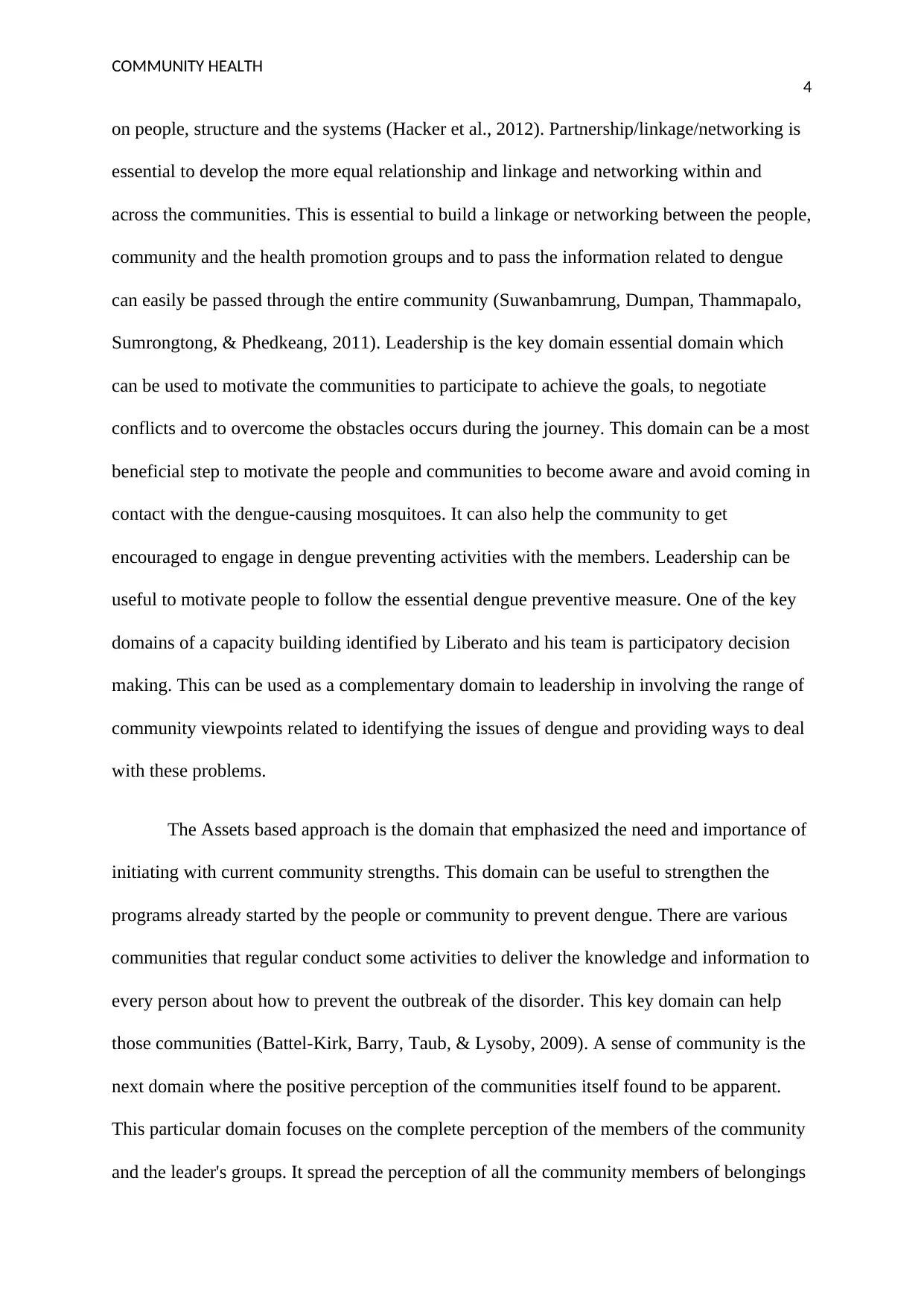
COMMUNITY HEALTH
4
on people, structure and the systems (Hacker et al., 2012). Partnership/linkage/networking is
essential to develop the more equal relationship and linkage and networking within and
across the communities. This is essential to build a linkage or networking between the people,
community and the health promotion groups and to pass the information related to dengue
can easily be passed through the entire community (Suwanbamrung, Dumpan, Thammapalo,
Sumrongtong, & Phedkeang, 2011). Leadership is the key domain essential domain which
can be used to motivate the communities to participate to achieve the goals, to negotiate
conflicts and to overcome the obstacles occurs during the journey. This domain can be a most
beneficial step to motivate the people and communities to become aware and avoid coming in
contact with the dengue-causing mosquitoes. It can also help the community to get
encouraged to engage in dengue preventing activities with the members. Leadership can be
useful to motivate people to follow the essential dengue preventive measure. One of the key
domains of a capacity building identified by Liberato and his team is participatory decision
making. This can be used as a complementary domain to leadership in involving the range of
community viewpoints related to identifying the issues of dengue and providing ways to deal
with these problems.
The Assets based approach is the domain that emphasized the need and importance of
initiating with current community strengths. This domain can be useful to strengthen the
programs already started by the people or community to prevent dengue. There are various
communities that regular conduct some activities to deliver the knowledge and information to
every person about how to prevent the outbreak of the disorder. This key domain can help
those communities (Battel-Kirk, Barry, Taub, & Lysoby, 2009). A sense of community is the
next domain where the positive perception of the communities itself found to be apparent.
This particular domain focuses on the complete perception of the members of the community
and the leader's groups. It spread the perception of all the community members of belongings
4
on people, structure and the systems (Hacker et al., 2012). Partnership/linkage/networking is
essential to develop the more equal relationship and linkage and networking within and
across the communities. This is essential to build a linkage or networking between the people,
community and the health promotion groups and to pass the information related to dengue
can easily be passed through the entire community (Suwanbamrung, Dumpan, Thammapalo,
Sumrongtong, & Phedkeang, 2011). Leadership is the key domain essential domain which
can be used to motivate the communities to participate to achieve the goals, to negotiate
conflicts and to overcome the obstacles occurs during the journey. This domain can be a most
beneficial step to motivate the people and communities to become aware and avoid coming in
contact with the dengue-causing mosquitoes. It can also help the community to get
encouraged to engage in dengue preventing activities with the members. Leadership can be
useful to motivate people to follow the essential dengue preventive measure. One of the key
domains of a capacity building identified by Liberato and his team is participatory decision
making. This can be used as a complementary domain to leadership in involving the range of
community viewpoints related to identifying the issues of dengue and providing ways to deal
with these problems.
The Assets based approach is the domain that emphasized the need and importance of
initiating with current community strengths. This domain can be useful to strengthen the
programs already started by the people or community to prevent dengue. There are various
communities that regular conduct some activities to deliver the knowledge and information to
every person about how to prevent the outbreak of the disorder. This key domain can help
those communities (Battel-Kirk, Barry, Taub, & Lysoby, 2009). A sense of community is the
next domain where the positive perception of the communities itself found to be apparent.
This particular domain focuses on the complete perception of the members of the community
and the leader's groups. It spread the perception of all the community members of belongings
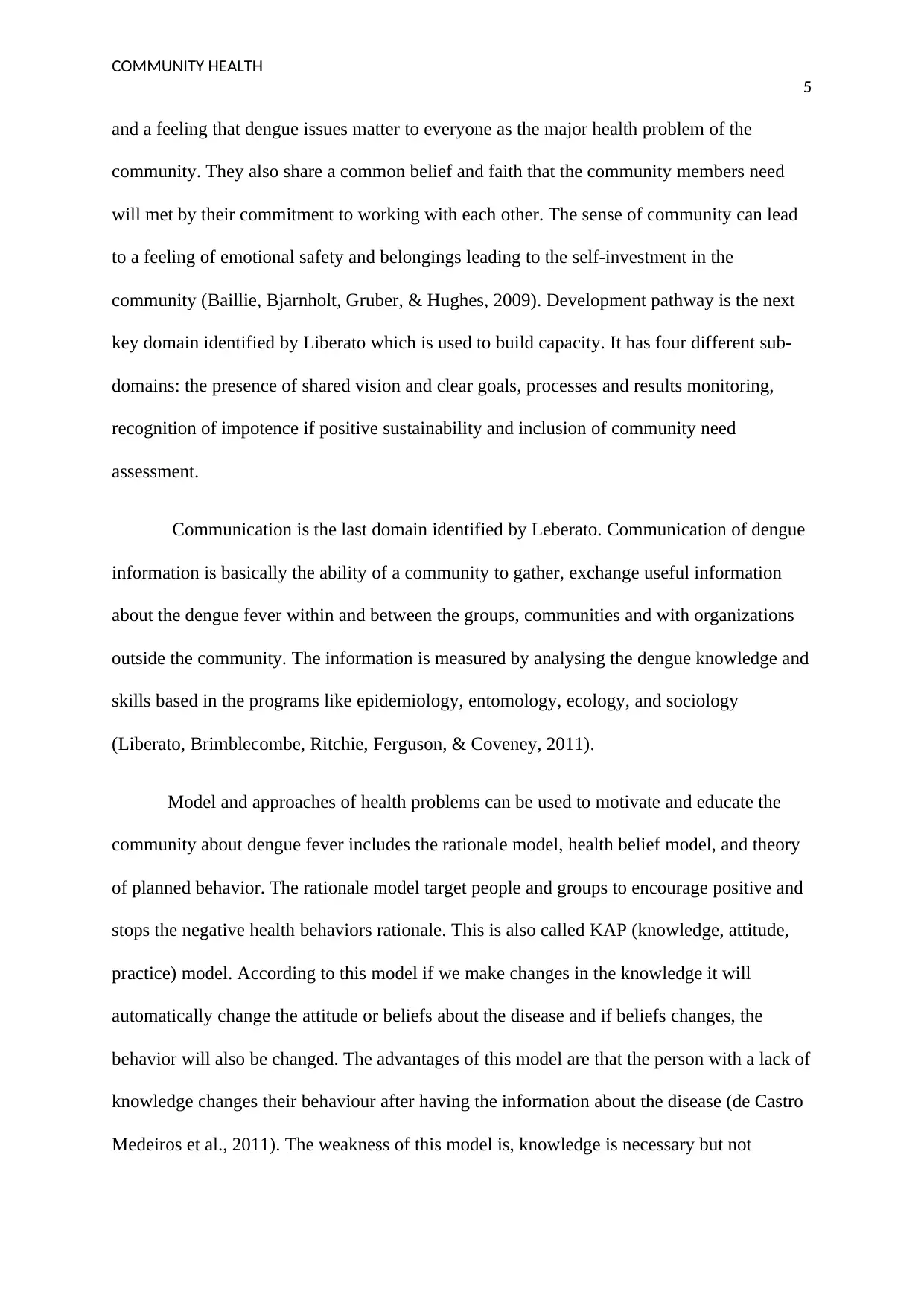
COMMUNITY HEALTH
5
and a feeling that dengue issues matter to everyone as the major health problem of the
community. They also share a common belief and faith that the community members need
will met by their commitment to working with each other. The sense of community can lead
to a feeling of emotional safety and belongings leading to the self-investment in the
community (Baillie, Bjarnholt, Gruber, & Hughes, 2009). Development pathway is the next
key domain identified by Liberato which is used to build capacity. It has four different sub-
domains: the presence of shared vision and clear goals, processes and results monitoring,
recognition of impotence if positive sustainability and inclusion of community need
assessment.
Communication is the last domain identified by Leberato. Communication of dengue
information is basically the ability of a community to gather, exchange useful information
about the dengue fever within and between the groups, communities and with organizations
outside the community. The information is measured by analysing the dengue knowledge and
skills based in the programs like epidemiology, entomology, ecology, and sociology
(Liberato, Brimblecombe, Ritchie, Ferguson, & Coveney, 2011).
Model and approaches of health problems can be used to motivate and educate the
community about dengue fever includes the rationale model, health belief model, and theory
of planned behavior. The rationale model target people and groups to encourage positive and
stops the negative health behaviors rationale. This is also called KAP (knowledge, attitude,
practice) model. According to this model if we make changes in the knowledge it will
automatically change the attitude or beliefs about the disease and if beliefs changes, the
behavior will also be changed. The advantages of this model are that the person with a lack of
knowledge changes their behaviour after having the information about the disease (de Castro
Medeiros et al., 2011). The weakness of this model is, knowledge is necessary but not
5
and a feeling that dengue issues matter to everyone as the major health problem of the
community. They also share a common belief and faith that the community members need
will met by their commitment to working with each other. The sense of community can lead
to a feeling of emotional safety and belongings leading to the self-investment in the
community (Baillie, Bjarnholt, Gruber, & Hughes, 2009). Development pathway is the next
key domain identified by Liberato which is used to build capacity. It has four different sub-
domains: the presence of shared vision and clear goals, processes and results monitoring,
recognition of impotence if positive sustainability and inclusion of community need
assessment.
Communication is the last domain identified by Leberato. Communication of dengue
information is basically the ability of a community to gather, exchange useful information
about the dengue fever within and between the groups, communities and with organizations
outside the community. The information is measured by analysing the dengue knowledge and
skills based in the programs like epidemiology, entomology, ecology, and sociology
(Liberato, Brimblecombe, Ritchie, Ferguson, & Coveney, 2011).
Model and approaches of health problems can be used to motivate and educate the
community about dengue fever includes the rationale model, health belief model, and theory
of planned behavior. The rationale model target people and groups to encourage positive and
stops the negative health behaviors rationale. This is also called KAP (knowledge, attitude,
practice) model. According to this model if we make changes in the knowledge it will
automatically change the attitude or beliefs about the disease and if beliefs changes, the
behavior will also be changed. The advantages of this model are that the person with a lack of
knowledge changes their behaviour after having the information about the disease (de Castro
Medeiros et al., 2011). The weakness of this model is, knowledge is necessary but not
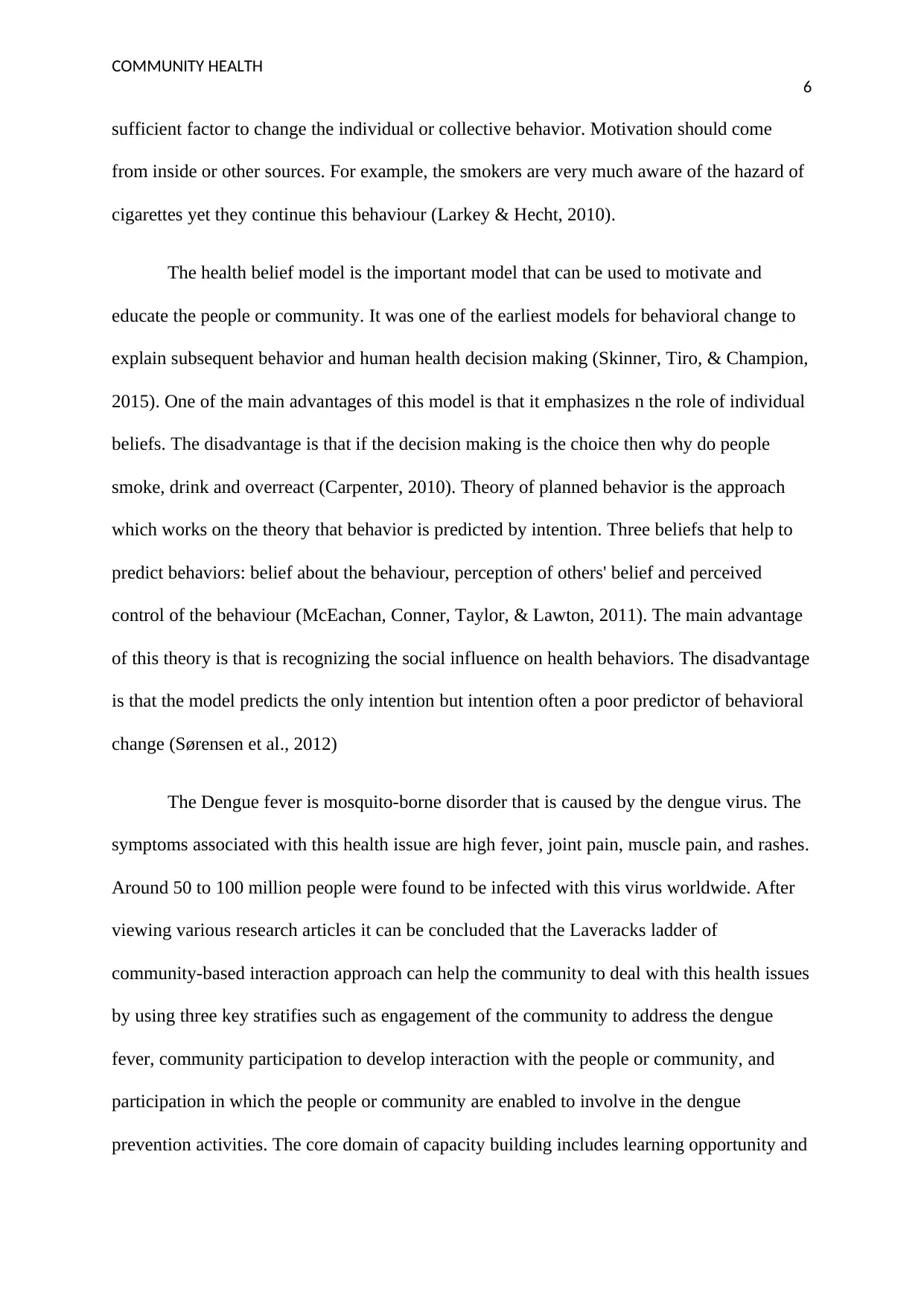
COMMUNITY HEALTH
6
sufficient factor to change the individual or collective behavior. Motivation should come
from inside or other sources. For example, the smokers are very much aware of the hazard of
cigarettes yet they continue this behaviour (Larkey & Hecht, 2010).
The health belief model is the important model that can be used to motivate and
educate the people or community. It was one of the earliest models for behavioral change to
explain subsequent behavior and human health decision making (Skinner, Tiro, & Champion,
2015). One of the main advantages of this model is that it emphasizes n the role of individual
beliefs. The disadvantage is that if the decision making is the choice then why do people
smoke, drink and overreact (Carpenter, 2010). Theory of planned behavior is the approach
which works on the theory that behavior is predicted by intention. Three beliefs that help to
predict behaviors: belief about the behaviour, perception of others' belief and perceived
control of the behaviour (McEachan, Conner, Taylor, & Lawton, 2011). The main advantage
of this theory is that is recognizing the social influence on health behaviors. The disadvantage
is that the model predicts the only intention but intention often a poor predictor of behavioral
change (Sørensen et al., 2012)
The Dengue fever is mosquito-borne disorder that is caused by the dengue virus. The
symptoms associated with this health issue are high fever, joint pain, muscle pain, and rashes.
Around 50 to 100 million people were found to be infected with this virus worldwide. After
viewing various research articles it can be concluded that the Laveracks ladder of
community-based interaction approach can help the community to deal with this health issues
by using three key stratifies such as engagement of the community to address the dengue
fever, community participation to develop interaction with the people or community, and
participation in which the people or community are enabled to involve in the dengue
prevention activities. The core domain of capacity building includes learning opportunity and
6
sufficient factor to change the individual or collective behavior. Motivation should come
from inside or other sources. For example, the smokers are very much aware of the hazard of
cigarettes yet they continue this behaviour (Larkey & Hecht, 2010).
The health belief model is the important model that can be used to motivate and
educate the people or community. It was one of the earliest models for behavioral change to
explain subsequent behavior and human health decision making (Skinner, Tiro, & Champion,
2015). One of the main advantages of this model is that it emphasizes n the role of individual
beliefs. The disadvantage is that if the decision making is the choice then why do people
smoke, drink and overreact (Carpenter, 2010). Theory of planned behavior is the approach
which works on the theory that behavior is predicted by intention. Three beliefs that help to
predict behaviors: belief about the behaviour, perception of others' belief and perceived
control of the behaviour (McEachan, Conner, Taylor, & Lawton, 2011). The main advantage
of this theory is that is recognizing the social influence on health behaviors. The disadvantage
is that the model predicts the only intention but intention often a poor predictor of behavioral
change (Sørensen et al., 2012)
The Dengue fever is mosquito-borne disorder that is caused by the dengue virus. The
symptoms associated with this health issue are high fever, joint pain, muscle pain, and rashes.
Around 50 to 100 million people were found to be infected with this virus worldwide. After
viewing various research articles it can be concluded that the Laveracks ladder of
community-based interaction approach can help the community to deal with this health issues
by using three key stratifies such as engagement of the community to address the dengue
fever, community participation to develop interaction with the people or community, and
participation in which the people or community are enabled to involve in the dengue
prevention activities. The core domain of capacity building includes learning opportunity and
Paraphrase This Document
Need a fresh take? Get an instant paraphrase of this document with our AI Paraphraser
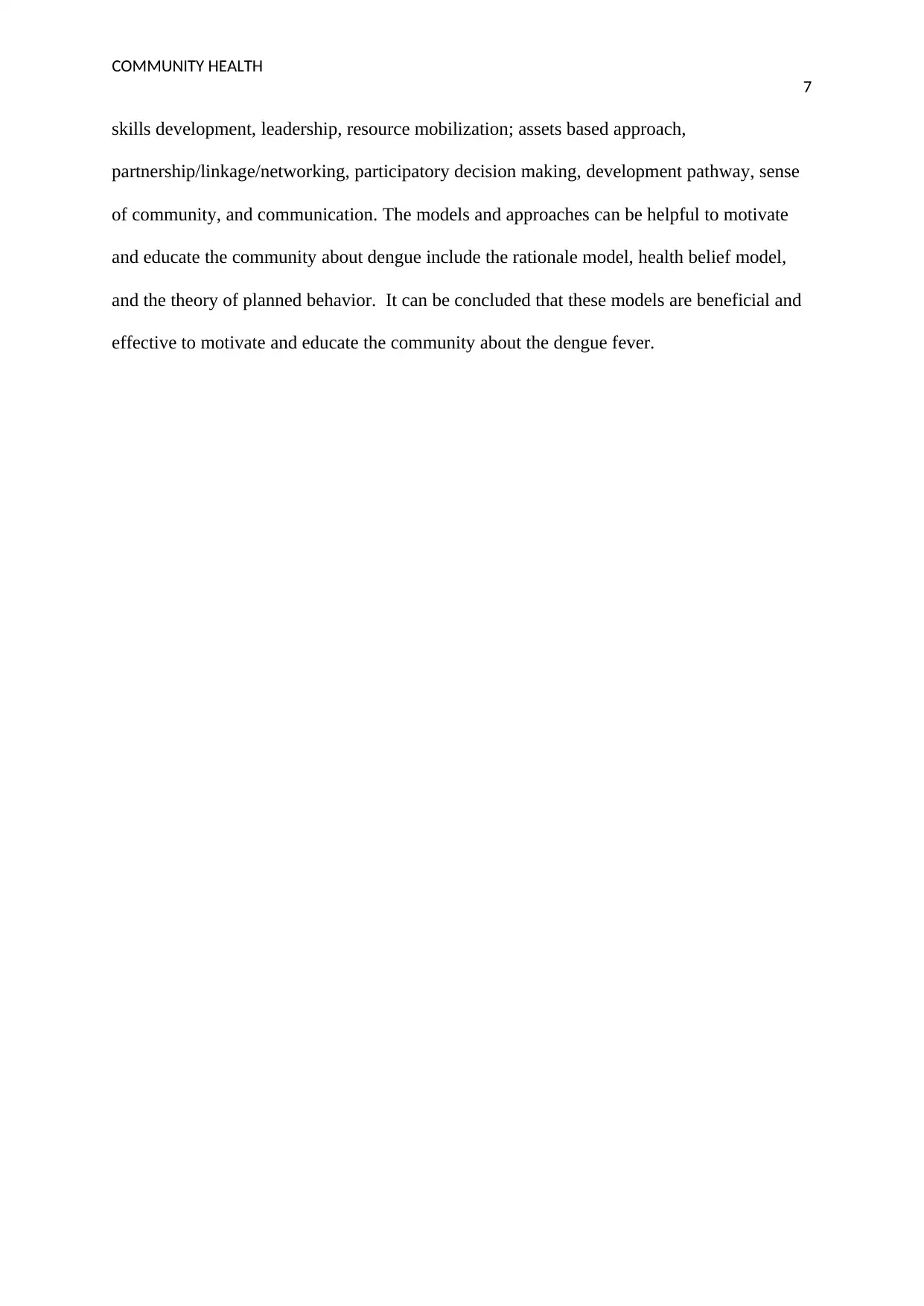
COMMUNITY HEALTH
7
skills development, leadership, resource mobilization; assets based approach,
partnership/linkage/networking, participatory decision making, development pathway, sense
of community, and communication. The models and approaches can be helpful to motivate
and educate the community about dengue include the rationale model, health belief model,
and the theory of planned behavior. It can be concluded that these models are beneficial and
effective to motivate and educate the community about the dengue fever.
7
skills development, leadership, resource mobilization; assets based approach,
partnership/linkage/networking, participatory decision making, development pathway, sense
of community, and communication. The models and approaches can be helpful to motivate
and educate the community about dengue include the rationale model, health belief model,
and the theory of planned behavior. It can be concluded that these models are beneficial and
effective to motivate and educate the community about the dengue fever.
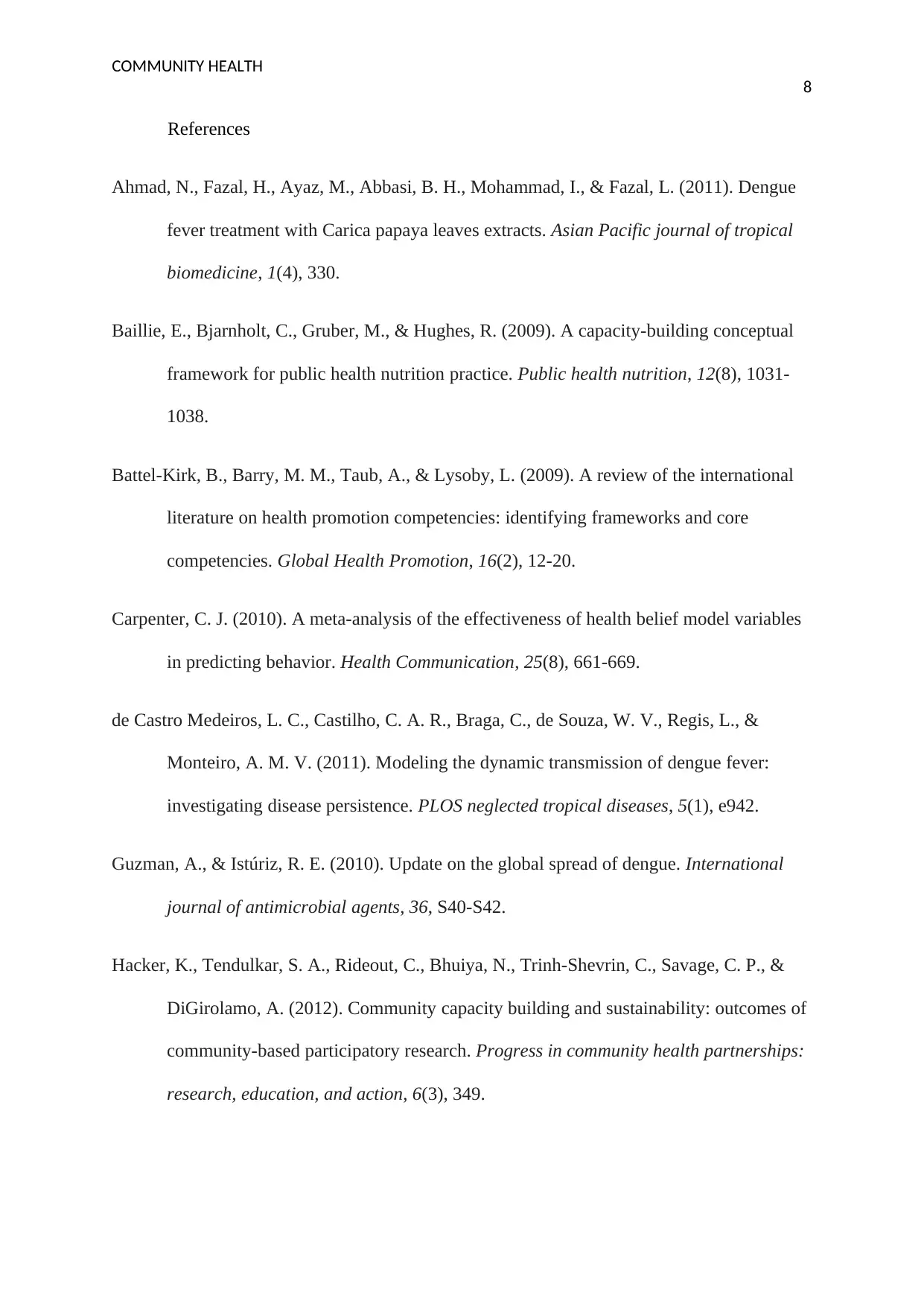
COMMUNITY HEALTH
8
References
Ahmad, N., Fazal, H., Ayaz, M., Abbasi, B. H., Mohammad, I., & Fazal, L. (2011). Dengue
fever treatment with Carica papaya leaves extracts. Asian Pacific journal of tropical
biomedicine, 1(4), 330.
Baillie, E., Bjarnholt, C., Gruber, M., & Hughes, R. (2009). A capacity-building conceptual
framework for public health nutrition practice. Public health nutrition, 12(8), 1031-
1038.
Battel-Kirk, B., Barry, M. M., Taub, A., & Lysoby, L. (2009). A review of the international
literature on health promotion competencies: identifying frameworks and core
competencies. Global Health Promotion, 16(2), 12-20.
Carpenter, C. J. (2010). A meta-analysis of the effectiveness of health belief model variables
in predicting behavior. Health Communication, 25(8), 661-669.
de Castro Medeiros, L. C., Castilho, C. A. R., Braga, C., de Souza, W. V., Regis, L., &
Monteiro, A. M. V. (2011). Modeling the dynamic transmission of dengue fever:
investigating disease persistence. PLOS neglected tropical diseases, 5(1), e942.
Guzman, A., & Istúriz, R. E. (2010). Update on the global spread of dengue. International
journal of antimicrobial agents, 36, S40-S42.
Hacker, K., Tendulkar, S. A., Rideout, C., Bhuiya, N., Trinh-Shevrin, C., Savage, C. P., &
DiGirolamo, A. (2012). Community capacity building and sustainability: outcomes of
community-based participatory research. Progress in community health partnerships:
research, education, and action, 6(3), 349.
8
References
Ahmad, N., Fazal, H., Ayaz, M., Abbasi, B. H., Mohammad, I., & Fazal, L. (2011). Dengue
fever treatment with Carica papaya leaves extracts. Asian Pacific journal of tropical
biomedicine, 1(4), 330.
Baillie, E., Bjarnholt, C., Gruber, M., & Hughes, R. (2009). A capacity-building conceptual
framework for public health nutrition practice. Public health nutrition, 12(8), 1031-
1038.
Battel-Kirk, B., Barry, M. M., Taub, A., & Lysoby, L. (2009). A review of the international
literature on health promotion competencies: identifying frameworks and core
competencies. Global Health Promotion, 16(2), 12-20.
Carpenter, C. J. (2010). A meta-analysis of the effectiveness of health belief model variables
in predicting behavior. Health Communication, 25(8), 661-669.
de Castro Medeiros, L. C., Castilho, C. A. R., Braga, C., de Souza, W. V., Regis, L., &
Monteiro, A. M. V. (2011). Modeling the dynamic transmission of dengue fever:
investigating disease persistence. PLOS neglected tropical diseases, 5(1), e942.
Guzman, A., & Istúriz, R. E. (2010). Update on the global spread of dengue. International
journal of antimicrobial agents, 36, S40-S42.
Hacker, K., Tendulkar, S. A., Rideout, C., Bhuiya, N., Trinh-Shevrin, C., Savage, C. P., &
DiGirolamo, A. (2012). Community capacity building and sustainability: outcomes of
community-based participatory research. Progress in community health partnerships:
research, education, and action, 6(3), 349.
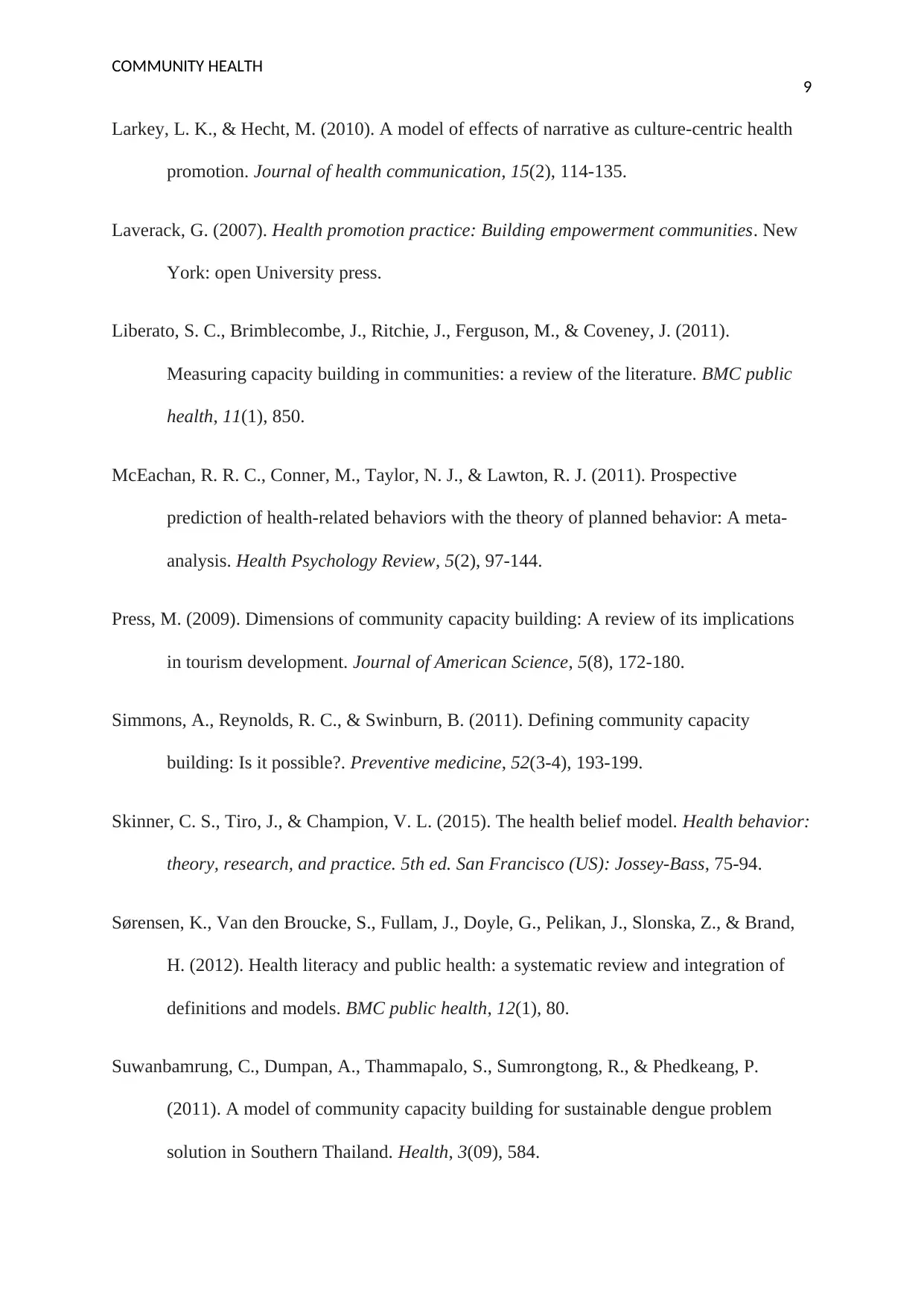
COMMUNITY HEALTH
9
Larkey, L. K., & Hecht, M. (2010). A model of effects of narrative as culture-centric health
promotion. Journal of health communication, 15(2), 114-135.
Laverack, G. (2007). Health promotion practice: Building empowerment communities. New
York: open University press.
Liberato, S. C., Brimblecombe, J., Ritchie, J., Ferguson, M., & Coveney, J. (2011).
Measuring capacity building in communities: a review of the literature. BMC public
health, 11(1), 850.
McEachan, R. R. C., Conner, M., Taylor, N. J., & Lawton, R. J. (2011). Prospective
prediction of health-related behaviors with the theory of planned behavior: A meta-
analysis. Health Psychology Review, 5(2), 97-144.
Press, M. (2009). Dimensions of community capacity building: A review of its implications
in tourism development. Journal of American Science, 5(8), 172-180.
Simmons, A., Reynolds, R. C., & Swinburn, B. (2011). Defining community capacity
building: Is it possible?. Preventive medicine, 52(3-4), 193-199.
Skinner, C. S., Tiro, J., & Champion, V. L. (2015). The health belief model. Health behavior:
theory, research, and practice. 5th ed. San Francisco (US): Jossey-Bass, 75-94.
Sørensen, K., Van den Broucke, S., Fullam, J., Doyle, G., Pelikan, J., Slonska, Z., & Brand,
H. (2012). Health literacy and public health: a systematic review and integration of
definitions and models. BMC public health, 12(1), 80.
Suwanbamrung, C., Dumpan, A., Thammapalo, S., Sumrongtong, R., & Phedkeang, P.
(2011). A model of community capacity building for sustainable dengue problem
solution in Southern Thailand. Health, 3(09), 584.
9
Larkey, L. K., & Hecht, M. (2010). A model of effects of narrative as culture-centric health
promotion. Journal of health communication, 15(2), 114-135.
Laverack, G. (2007). Health promotion practice: Building empowerment communities. New
York: open University press.
Liberato, S. C., Brimblecombe, J., Ritchie, J., Ferguson, M., & Coveney, J. (2011).
Measuring capacity building in communities: a review of the literature. BMC public
health, 11(1), 850.
McEachan, R. R. C., Conner, M., Taylor, N. J., & Lawton, R. J. (2011). Prospective
prediction of health-related behaviors with the theory of planned behavior: A meta-
analysis. Health Psychology Review, 5(2), 97-144.
Press, M. (2009). Dimensions of community capacity building: A review of its implications
in tourism development. Journal of American Science, 5(8), 172-180.
Simmons, A., Reynolds, R. C., & Swinburn, B. (2011). Defining community capacity
building: Is it possible?. Preventive medicine, 52(3-4), 193-199.
Skinner, C. S., Tiro, J., & Champion, V. L. (2015). The health belief model. Health behavior:
theory, research, and practice. 5th ed. San Francisco (US): Jossey-Bass, 75-94.
Sørensen, K., Van den Broucke, S., Fullam, J., Doyle, G., Pelikan, J., Slonska, Z., & Brand,
H. (2012). Health literacy and public health: a systematic review and integration of
definitions and models. BMC public health, 12(1), 80.
Suwanbamrung, C., Dumpan, A., Thammapalo, S., Sumrongtong, R., & Phedkeang, P.
(2011). A model of community capacity building for sustainable dengue problem
solution in Southern Thailand. Health, 3(09), 584.
1 out of 10
Related Documents
Your All-in-One AI-Powered Toolkit for Academic Success.
+13062052269
info@desklib.com
Available 24*7 on WhatsApp / Email
![[object Object]](/_next/static/media/star-bottom.7253800d.svg)
Unlock your academic potential
© 2024 | Zucol Services PVT LTD | All rights reserved.




